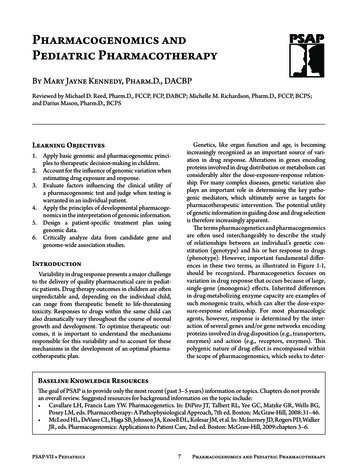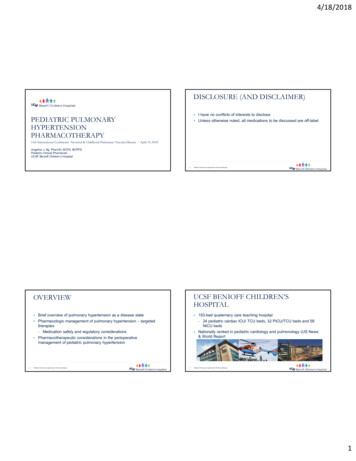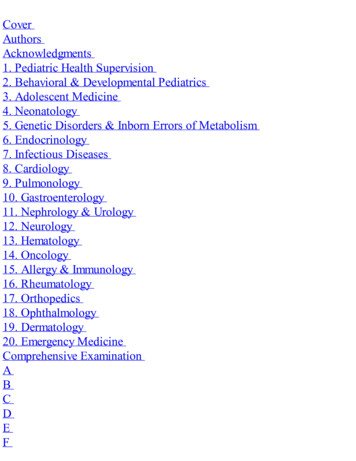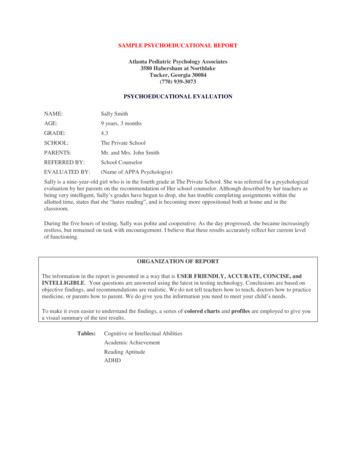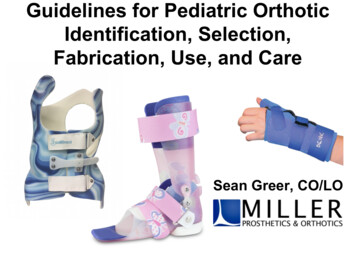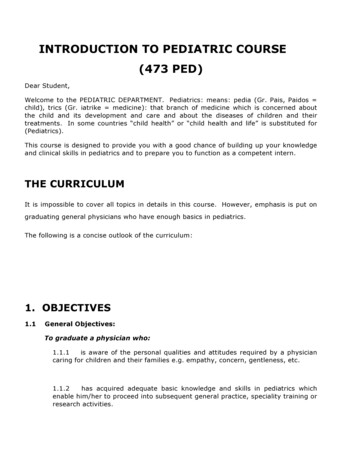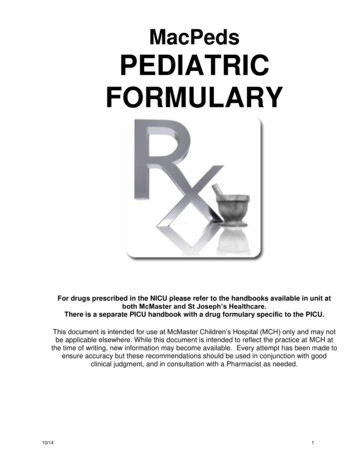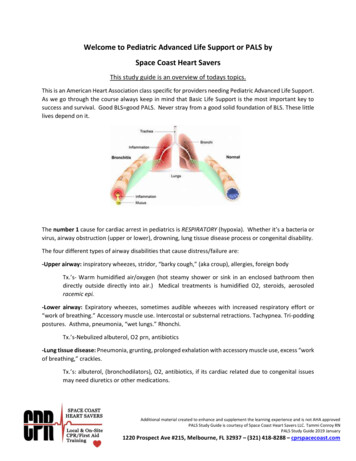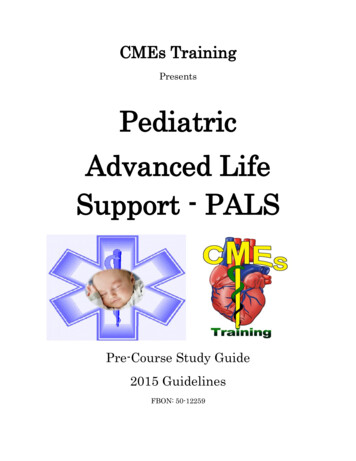
Transcription
InfoCard #: PBMT-GEN-048 Rev. 06 Effective Date: 02 Jun 2020PEDIATRIC BLOOD AND MARROWTRANSPLANT PROGRAMDOCUMENT NUMBER: PBMT-GEN-048DOCUMENT TITLE:Administration of ThiotepaDOCUMENT NOTES:Document InformationRevision: 06Vault: PBMT-General-relStatus: ReleaseDocument Type: PBMTDate InformationCreation Date: 04 May 2020Release Date: 02 Jun 2020Effective Date: 02 Jun 2020Expiration Date:Control InformationAuthor: MOORE171Owner: MOORE171Previous Number: PBMT-GEN-048 Rev 05Change Number: PBMT-CCR-289CONFIDENTIAL - Printed on 02 Jun 2020
InfoCard #: PBMT-GEN-048 Rev. 06 Effective Date: 02 Jun 2020PBMT-GEN-048ADMINISTRATION OF THIOTEPA123PURPOSE1.1Outline the procedure required for administration of thiotepa.1.2Describe the responsibilities of the nursing staff for administering and monitoringreactions to thiotepa.INTRODUCTION2.1Thiotepa is a cell cycle non-specific polyfunctional alkylating agent.2.2Thiotepa exerts its chemotherapeutic effects by alkylating DNA(deoxyribonucleic acid), causing interstrand crosslinking, inhibiting proteinsynthesis, and causing cell death.2.2.1Adverse effects include thrombocytopenia, leukopenia,neutropenia, anemia, and somet imes pancytopenia, nausea,vo mit ing, skin rash or peeling of the skin (sunburn appearance),dizziness, headache, hives, darkening of the skin.2.2.2Thiotepa can cause severe skin toxicity including complete sloughing ofthe dermis. Extreme care must be taken to protect patients from thistoxicity, including but not limited to frequent bathing for a minimum of24 hours after each dose.2.2.3Nursing staff administering thiotepa and caregivers must be protectedfrom exposure to the drug, which is partially excreted through the skin.SCOPE AND RESPONSIBILITIES3.13.2Interdisciplinary: Attending physicians, advanced practice providers (APPs),pharmacists and registered nurses (RNs) are all responsible for the contents of thisprocedure.3.1.1The nurse is responsible for administration of melphalan, managementof side effects and assessment of response.3.1.2The attending physician is responsible for placing chemotherapy orderin the medical records.3.1.3The physician and advanced practice providers are responsible forassessment and direction of management of patient.3.1.4The pharmacist is responsible for review of the chemotherapy order andall downstream pharmacy processes in compliance withchemotherapeutic policies and procedures.Registered nurses (RNs) may administer thiotepa after successful completion ofthe medication administration test, the chemotherapy certification test anddemonstration of clinical competency with their preceptors.PBMT-GEN-048 Administration of ThiotepaPBMT, DUMCDurham, NCCONFIDENTIAL - Printed on 02 Jun 2020Page 1 of 3
InfoCard #: PBMT-GEN-048 Rev. 06 Effective Date: 02 Jun 2020456DEFINITIONS/ACRONYMS4.1APPAdvanced Practice Provider4.2DNADeoxyribonucleic acid4.3PPEPersonal Protective Equipment4.4RNRegistered NurseMATERIALS5.1See the health-system related policy: Chemotherapy Administration Policy.5.20.22 micron filterEQUIPMENT6.17SAFETY7.18See the health-system related policy: Chemotherapy Administration Policy.Use appropriate Personal Protective Equipment (PPE) when handlingchemotherapy. See the health-system related policy: ChemotherapyAdministration Policy.PROCEDURE8.1See over-arching procedural steps, including steps for patient assessment andchemotherapy administration steps, in the health-system related policy:Chemotherapy Administration Policy.8.2Patient assessment will be performed as outlined in the health-system relatedpolicy: Chemotherapy Administration Policy.8.3Additionally:8.3.1Educate caregivers about excretion of thiotepa through the skin and theimportance of bathing.8.3.2A chemo gown MUST be worn anytime the healthcare team and/orcaregiver holds the patient, starting at the end of the first infusion ofthiotepa and continuing until 24 hours after the last infusion of thiotepa.Each time the child is held, a new gown should be worn.8.3.3Gloves MUST be worn anytime someone comes in physical contactwith the patient starting at the end of the first infusion of thiotepa andcontinuing until 24 hours after the last infusion of thiotepa. New glovesMUST be worn with each new contact.8.3.4Patients will receive sponge showers and/or standing showers every 6hours starting at the end of the first infusion and continuing until 24hours after the last infusion of thiotepa.8.3.5Patients may use Kindest Kare soap provided by the hospital but shouldnot use ANY type of lotions or creams on the skin for at least 24 hoursafter the last dose of thiotepa.PBMT-GEN-048 Administration of ThiotepaPBMT, DUMCDurham, NCCONFIDENTIAL - Printed on 02 Jun 2020Page 2 of 3
InfoCard #: PBMT-GEN-048 Rev. 06 Effective Date: 02 Jun 20208.48.3.6After each sponge shower and/or standing shower, the patient’s entirebedding should be placed in a dirty linens container and new linens areto be placed on patient’s bed.8.3.7Patient must change into a clean set of clothes with each sponge showerand/or standing shower, it is acceptable to wear a hospital gown andplace a new gown on with each bath/shower8.3.8NO occlusive dressing should be placed on the patient. The centralvenous line dressing should be changed every 4 to 6 hours with eachbath and the site should be covered with 2x2 sterile gauze, then 4x4sterile gauze and the Xspan tubular dressing retainer. With eachdressing change, new gauze and new Xspan tubular dressing retainershould be placed on the patient.8.3.9Patients may wear a pulse-oximeter but the site should be changed every2 to 4 hours.8.3.10Patients may be placed on the cardiac monitor with leads and the leadsites must be changed every 4 to 6 hours with each bath or shower.Administration8.4.19Chemotherapy administration will be performed as outlined inChemotherapy Administration Policy.RELATED DOCUMENTS/FORMS9.1.1Duke University Health System policy: Chemotherapy AdministrationPolicy10 REFERENCES10.1 Duke Online Clinical Pharmacology11 REVISION HISTORYRevision No.06AuthorS. McCollumDescription of Change(s)- Acronyms defined: APP, DNA- “sponge bath” wording changed to “sponge shower”for clarity that baths are not allowed around thiotepaadministration.- Scope updated to include all applicable job roles.- Related document title updated to PBMT-GEN-069Administration of Chemotherapy Inpatient Unit-5200removed as no longer applicable. Replaced with DUHchemotherapy policy.PBMT-GEN-048 Administration of ThiotepaPBMT, DUMCDurham, NCCONFIDENTIAL - Printed on 02 Jun 2020Page 3 of 3
InfoCard #: PBMT-GEN-048 Rev. 06 Effective Date: 02 Jun 2020Signature ManifestDocument Number: PBMT-GEN-048Title: Administration of ThiotepaEffective Date: 02 Jun 2020Revision: 06All dates and times are in Eastern Time.PBMT-GEN-048 Administration of ThiotepaAuthorName/SignatureTitleSally McCollum (MOORE171)DateMeaning/Reason05 May 2020, 11:54:44 AMApprovedDateMeaning/Reason05 May 2020, 05:32:35 PMApprovedDateMeaning/Reason08 May 2020, 12:16:33 PMApprovedDateMeaning/Reason11 May 2020, 12:10:36 PMApprovedMedical DirectorName/SignatureTitleJoanne Kurtzberg (KURTZ001)QualityName/SignatureTitleBing Shen (BS76)Document ReleaseName/SignatureBetsy Jordan (BJ42)TitleCONFIDENTIAL - Printed on 02 Jun 2020
8.3.8 NO occlusive dressing should be placed on the patient. The central venous line dressing should be changedevery 4 to 6 hours with each bath and the site should be covered with 2x2 sterile gauze, then 4x4 sterile gauze and theXspan tubular dressing retainer. With each dressing change,new gauze and new Xspan tubulardressing retainer

